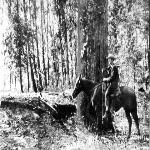The magnitude 5.8 earthquake that rattled the East Coast of the United States in August caught everyone - even geologists - by surprise. But even when there's reason to think an earthquake could be around the corner, scientists still can't make good predictions.
It's been 200 years since big earthquakes rocked the New Madrid Seismic Zone, a fault system that runs down the central U.S. through parts of Illinois, Missouri, Kentucky, Arkansas and Tennessee. The region has had plenty of smaller quakes since then, but no one can really say when the next big one might be.
The New Madrid earthquakes of the winter of 1811 to 1812 have become the stuff of legend. They were so powerful, the story goes, they made the Mississippi River run backwards.
"It was what we call a thrust fault," says Susan Hough of the U.S. Geological Survey in Pasadena, California. "And it came up to the surface beneath the river and actually created a stair step in the river bottom, to where it set up waves that went coursing back upstream."
According to Hough, much of what we know about those early quakes comes from first-hand accounts, like this one written by future United States president Zachary Taylor, who felt the shaking 370 kilometers away in Louisville, Kentucky.
The sight was truly awful: houses cracking; chimneys falling; men, women and children running in every direction - in their shirts - for safety and a friend of mine was so much alarmed as to jump (out) of a window and was very much hurt.
Hough's calculations put the largest New Madrid earthquake at about 7.0, the same magnitude as the January 2010 earthquake in Haiti. The official USGS estimate is 7.7.
The problem is, scientists can't predict when, where, or even if another earthquake will happen.
Northwestern University geophysicist Seth Stein doesn't expect another big quake at New Madrid anytime soon. He and others have been using GPS technology to measure how the ground moves - or deforms - along active faults.
"Now, normally the way earthquakes work is that you store up energy, the ground deforms before a big earthquake - kind of like stretching a spring - and then it snaps, and you have an earthquake," Stein says.
That warping of the ground has been measured in California, Alaska, Oregon, and Washington - along every U.S. fault where we think a big earthquake is on the way. So that's what Stein and his colleagues expected to see when they started taking those same kinds of GPS measurements at New Madrid.
To their complete surprise, they saw absolutely no motion of the ground. Stein says part of the explanation could be that seismic zones in the middle of a continent seem to behave differently from those in places like California, where the huge plates that make up the earth's surface thrust up against each other.
"Faults in the middle of the continents will be active for short periods of time geologically, maybe a few thousand years, and then they'll turn off and be inactive for times, and then start up again," he says. "So it looks like we may be seeing the end of one of those cycles."
But many other geologists don't agree. Robert Williams of the USGS in Colorado says you can't ignore the past. The earthquakes 200 years ago liquefied the soil underground, blasting jets of wet sand out onto the surface.
"There's been some great science done, with geologists digging into these 1811, 1812 sand blows, and then, lo and behold, discovering evidence for older sand blows caused by earthquakes of about the same magnitude as the 1811, 1812 sequence," Williams says.
They realized that before 1811, there had been quakes in about 1450, and again before that, in 900. Williams says that pattern of very large earthquakes means another big one could be on the way.
"We can't predict earthquakes. So the geologic record is really the strongest piece of evidence we have to remain concerned about earthquakes there in the New Madrid region."
Experts hope by the time the next big quake does hit the region, we'll be ready for it.
